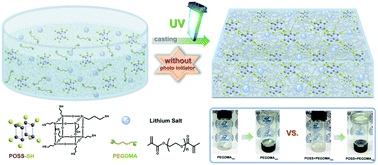Facile fabrication of a hybrid polymer electrolyte via initiator-free thiol–ene photopolymerization for high-performance all-solid-state lithium metal batteries†
Abstract
A novel all-solid-state hybrid polymer electrolyte (HPE) with mechanical robustness was fabricated via initiator-free thiol–ene photopolymerization triggered by UV irradiation. The thiolated polyhedral oligomeric silsesquioxane (POSS-SH) prepared by the hydrolysis of (3-mercaptopropyl) trimethoxysilane offers a reactive thiol group and endows high mechanical strength resulting from the POSS core. The HPE was fabricated via thiol–ene photopolymerization of POSS-SH and polyethylene glycol dimethylacrylate (PEGDMA) to form a cross-linked network, and the ionic conductivity of HPE was enhanced through the continuous migration of lithium ion via the PEG chain. The formed HPE was mechanically robust and flexible due to the hybrid POSS core and the cross-linked structure. It exhibits good thermal stability up to 285 °C with 5% decomposition of the polymer matrix and the interfacial stability with lithium foil. The POSS-based hybrid polymer electrolyte (PHPE) shows better stretchability and excellent ionic conductivity up to 2.1 × 10−4 S cm−1 at 30 °C than the polymer electrolyte prepared by photopolymerization of PEGDMA in the absence of POSS-SH. Furthermore, assembled with LiFePO4 and lithium foil, the resulting coin cell has good reversible specific capacity and considerable rate capability.



 Please wait while we load your content...
Please wait while we load your content...